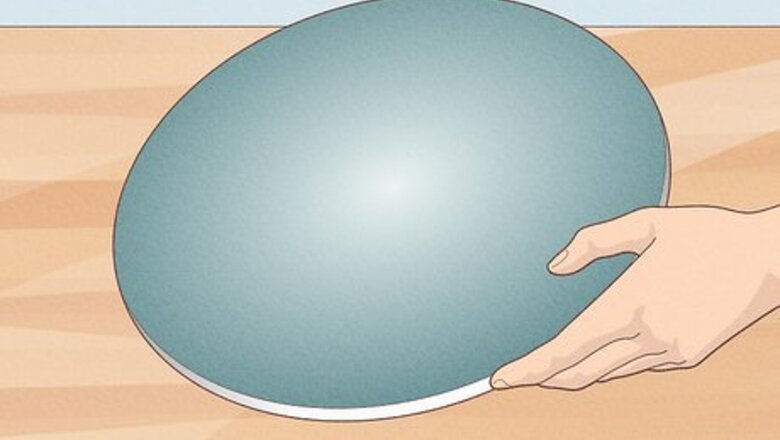
views
Choosing Your Supplies

Get a lacemaking pillow to work on. These are not the same as standard pillows. The polystyrene foam in a lacemaking pillow is firm and sturdy, so it holds the pins in place. The pillow is usually shaped like a rounded dome (known as a cookie pillow), an oval made up of moveable pillow blocks (called a block pillow), or a cylinder (known as a roller pillow). A cookie pillow is good for beginners and basic lacemaking. Block pillows are best for creating long or wide pieces of lace. Roller pillows work well for creating long strips of lace.

Choose a pattern. A pattern is necessary for making bobbin lace. You can find lots of free lacemaking patterns online, or you can purchase a pattern book. You will need a printout of the pattern because you will be working directly over it on your pillow. Print out a pattern or purchase a paper copy of the pattern you want to use. Patterns included in pattern books are often printed on thick paper so they can be reused again and again. If you print out a pattern on computer paper, you will only be able to use it 1 time. It is recommended that you prick the pattern before you use it. This means that you use a pin to poke a hole through each of the dots marked on the pattern.
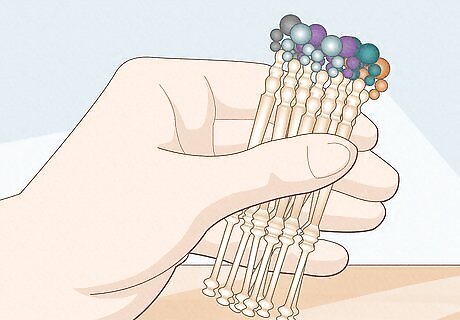
Get the number of bobbins required for your pattern. Lace bobbins only come in 1 size, which is a 4 in (10 cm) long stick. Check your pattern to find out exactly how many bobbins you will need. This number will vary depending on the complexity of the bobbin lace pattern. For example, a simple pattern may only require 6 pairs of bobbins, which is a total of 12 bobbins. However, more complex patterns may require 50 pairs of bobbins, which is a total of 100 bobbins! Lace bobbins come in wood and plastic. Plastic bobbins are cheaper than wood ones. Bobbins also usually have some sort of decorative end, but this will not affect the results you get.
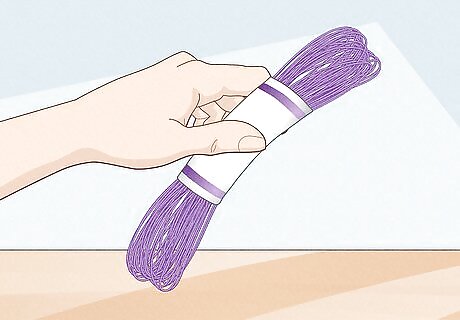
Select a bobbin lace thread that won’t stretch or break. You can use any type or color thread you want to make bobbin lace as long as it will not stretch or break. If you are just starting out, then try practicing with some cheap sewing thread in the color or colors of your choice. You can pick up spools of thread at your local craft supply store or just use whatever type of thread you have around. Cotton, silk, and linen thread are good options. Keep in mind that the thickness of the thread may affect the look of your lace depending on the pattern. Check your pattern to see what type of thread is recommended. You can use cream-colored thread for an antique look, or choose a more colorful thread if desired.
Winding the Bobbins
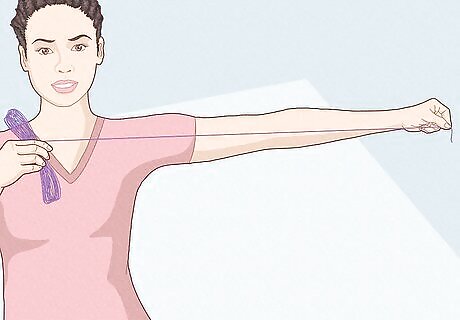
Measure a piece of thread from arm-to-arm or arm-to-chest. Grasp the end of the thread with 1 hand and hold the spool with the other hand. Pull out the strand until it spans your entire chest, and cut the thread at the center of your chest for an arm-to-chest measurement. For an arm-to-arm measurement, pull out the strand until it spans from 1 hand to the other with your arms outstretched. Then, cut the thread at the spool. Your pattern may indicate a specific measurement, or it may simply advise you to do an arm-to-arm or arm-to-chest measurement. These are traditional ways of measuring thread for lacemaking. Check your pattern to see which measurement is required.

Wind an equal amount of thread onto each of the bobbins in a pair. A single strand of thread will be connecting 2 bobbins, so you will need to pair off your bobbins and wrap each end of the thread around 1 of the 2 bobbins. Take the end of 1 of the strands and hold it against the indentation in 1 of your bobbins. Then, begin winding the thread around the bobbin until you have wound about half of the length of thread onto it. Repeat the same winding process for the second bobbin in a pair.
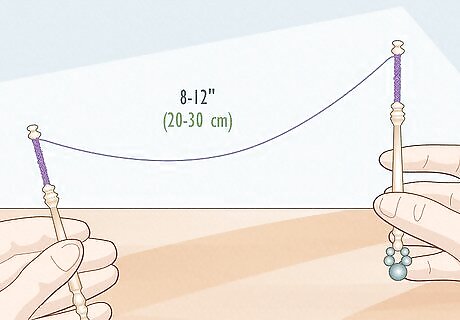
Unravel 8 to 12 inches (20 to 30 cm) of thread between the 2 bobbins. You will need a length of thread between the 2 bobbins that you can work to create your lace. Unravel from both bobbins equally to provide this extra thread. The amount of thread that hangs down from the pins will be half of what you leave between the 2 bobbins.
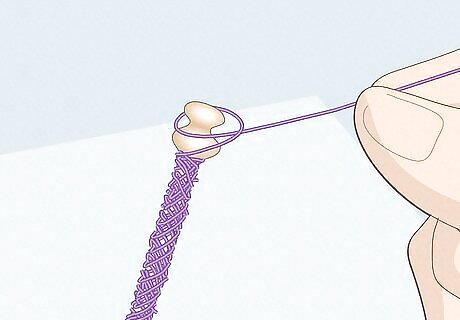
Make a loop to secure the thread on each bobbin. To prevent the bobbins from completely unraveling, make a loop with the thread hanging from each bobbin. Twist the loop 1 time at its base, and slide it onto the bobbin. This loop should secure the thread that is already on the bobbin and prevent it from unraveling while the bobbin hangs from the pillow. Each time you need to unravel more thread, you will need to undo the loop, loosen the thread, and redo the loop again.
Positioning the Pillow, Pins, and Thread
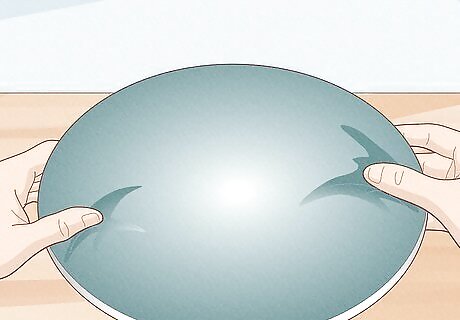
Sit with the pillow on your lap or on a table in front of you. You may find it easier to work while sitting in a chair with the pillow on your lap, or you might find it easier to work with the pillow resting on a table. Do whatever feels most comfortable to you. The bobbins will need to hang down below the pattern while you work, so it is best to have the pillow at a slight angle while you work. Try putting your feet up on a stool in front of you to bend your knees and angle the pillow. If you prefer to sit at a table, you can angle the pillow by propping up the back of it with a book or another small pillow.
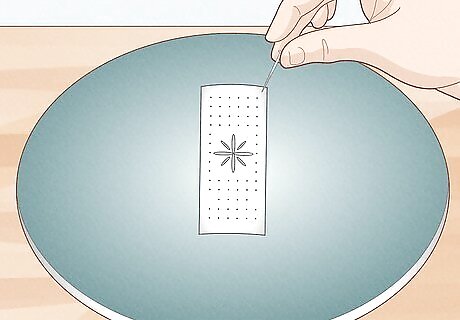
Pin your pattern onto your lacemaking pillow. The pattern will need to be secured to the pillow well before you begin. Choose a central location on the pillow that will allow you to work the entire pattern easily. For a piece of lace that you can work easily on a small section of the pillow, pin the pattern in the center of the pillow. If you are using a cookie pillow to create a long piece of lace, pin the pattern up high on the pillow. If you are working with a block or roller pillow, you can pin the pattern anywhere and move the pillow pieces or the pillow as needed.

Insert the pins where indicated at the top of the pattern. Your pattern will have many small dots in it where you will need to place pins to work the lace. The first row of pins will be at the very top of the pattern. Insert 1 pin into each dot to get started. After you finish a row of stitches, you will need to place additional pins where indicated by your pattern.
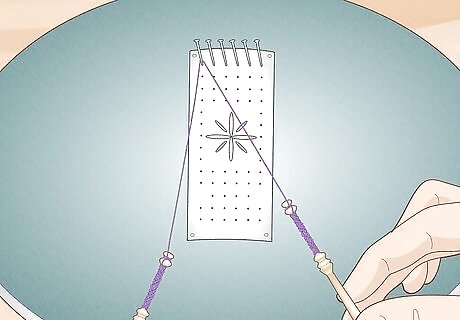
Loop the section of thread between 2 bobbins around each of the pins. Take a pair of bobbins and bring the length of thread that is between them up and over the first pin. Allow the bobbins to hand down from the pin. Repeat this for the next pin using your next pair of bobbins. Continue looping thread around bobbins all the way to the end of the row of pins in your pattern.
Working Bobbin Lace Stitches
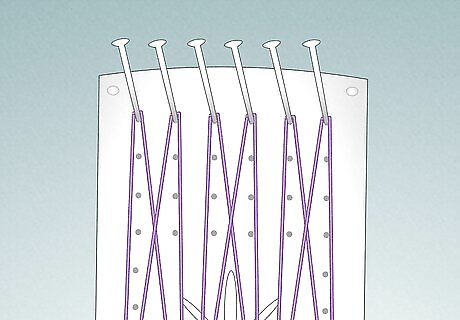
Cross neighboring bobbins when indicated by the pattern. A cross is represented by a “C” in bobbin lace patterns. When you see a C, this means that you need to take the 2 bobbins on either side of the C and cross them over each other 1 time. Keep in mind that a cross is not a stitch on its own. It is 1 of the movements that you will use to create different types of stitches.
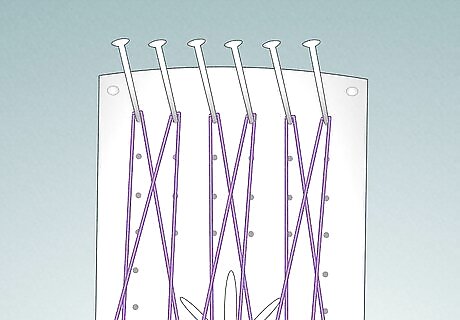
Swap the positions of 2 pairs of neighboring bobbins to do a twist. A twist (represented as “T” in patterns) usually follows a cross. This is when you take 2 pairs of neighboring bobbins and swap their positions. A twist is a component of a stitch and not a stitch itself.
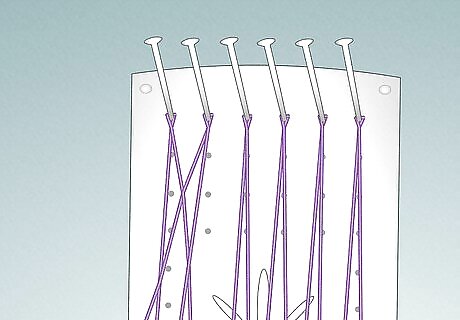
Switch the middle 2 bobbins and the neighboring bobbins to half stitch. A common stitch that you will see often in lacemaking is a half stitch. This is when you cross the middle 2 neighboring bobbins in a set of 4 over each other. Then, swap the positions of the first and second bobbins as well as the third and fourth bobbins. For these types of stitches, you might find it helpful to label each of your bobbins in groups of 4, such as bobbins 1, 2, 3, and 4, or A, B, C, and D.
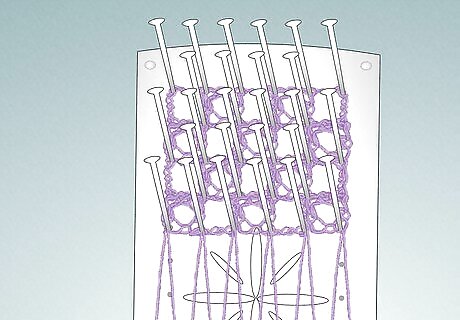
Follow the pattern’s instructions to create more advanced stitches. There are lots of different types of bobbin lace stitches, but they all build on the basic concepts of crossing and twisting. Once you have mastered the basics, try following a more advanced pattern’s instructions to learn new stitches. For example, a cross (C), twist (T), and then another cross (C) makes a cloth stitch, which you will also see often in patterns.
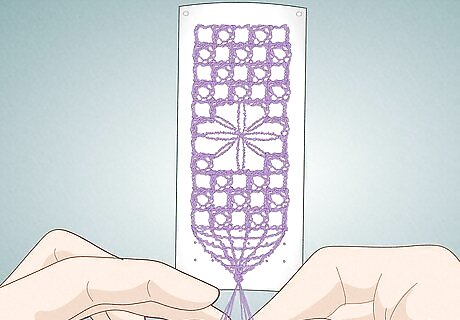
Tie pairs of hanging threads in knots and cut the excess. When you have finished working your lace pattern, you will need to secure the ends of the thread. Tie together the ends of neighboring pairs of hanging thread 2 times to form a knot between them. Unravel the thread from the bobbins completely to do this. Only unravel 2 strands at a time and tie the 2 strands into a knot. Repeat to the end of the row. Snip off the excess threads as you go.



















Comments
0 comment